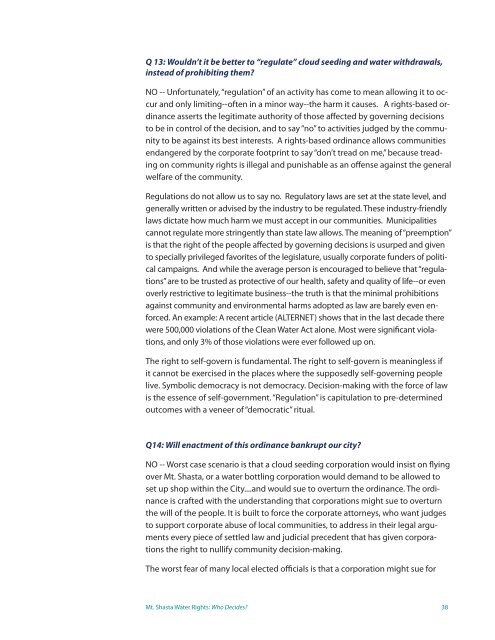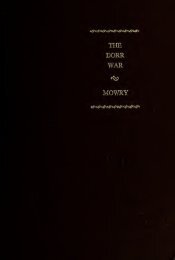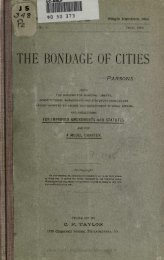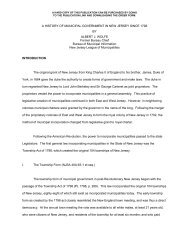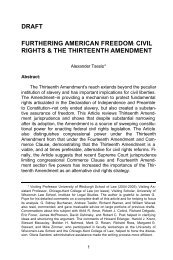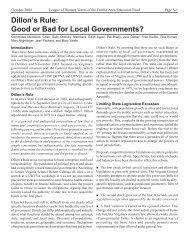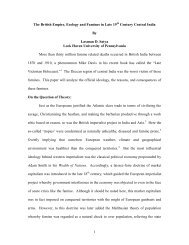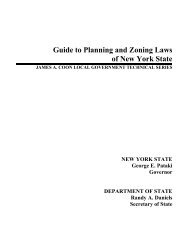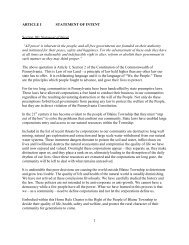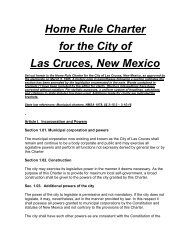Mt Shasta Water Rights: WHO DECIDES? - The Community ...
Mt Shasta Water Rights: WHO DECIDES? - The Community ...
Mt Shasta Water Rights: WHO DECIDES? - The Community ...
Create successful ePaper yourself
Turn your PDF publications into a flip-book with our unique Google optimized e-Paper software.
Q 13: Wouldn’t it be better to “regulate” cloud seeding and water withdrawals,instead of prohibiting them?NO -- Unfortunately, “regulation” of an activity has come to mean allowing it to occurand only limiting--often in a minor way--the harm it causes. A rights-based ordinanceasserts the legitimate authority of those affected by governing decisionsto be in control of the decision, and to say “no” to activities judged by the communityto be against its best interests. A rights-based ordinance allows communitiesendangered by the corporate footprint to say “don’t tread on me,” because treadingon community rights is illegal and punishable as an offense against the generalwelfare of the community.Regulations do not allow us to say no. Regulatory laws are set at the state level, andgenerally written or advised by the industry to be regulated. <strong>The</strong>se industry-friendlylaws dictate how much harm we must accept in our communities. Municipalitiescannot regulate more stringently than state law allows. <strong>The</strong> meaning of “preemption”is that the right of the people affected by governing decisions is usurped and givento specially privileged favorites of the legislature, usually corporate funders of politicalcampaigns. And while the average person is encouraged to believe that “regulations”are to be trusted as protective of our health, safety and quality of life--or evenoverly restrictive to legitimate business--the truth is that the minimal prohibitionsagainst community and environmental harms adopted as law are barely even enforced.An example: A recent article (ALTERNET) shows that in the last decade therewere 500,000 violations of the Clean <strong>Water</strong> Act alone. Most were significant violations,and only 3% of those violations were ever followed up on.<strong>The</strong> right to self-govern is fundamental. <strong>The</strong> right to self-govern is meaningless ifit cannot be exercised in the places where the supposedly self-governing peoplelive. Symbolic democracy is not democracy. Decision-making with the force of lawis the essence of self-government. “Regulation” is capitulation to pre-determinedoutcomes with a veneer of “democratic” ritual.Q14: Will enactment of this ordinance bankrupt our city?NO -- Worst case scenario is that a cloud seeding corporation would insist on flyingover <strong>Mt</strong>. <strong>Shasta</strong>, or a water bottling corporation would demand to be allowed toset up shop within the City....and would sue to overturn the ordinance. <strong>The</strong> ordinanceis crafted with the understanding that corporations might sue to overturnthe will of the people. It is built to force the corporate attorneys, who want judgesto support corporate abuse of local communities, to address in their legal argumentsevery piece of settled law and judicial precedent that has given corporationsthe right to nullify community decision-making.<strong>The</strong> worst fear of many local elected officials is that a corporation might sue for<strong>Mt</strong>. <strong>Shasta</strong> <strong>Water</strong> <strong>Rights</strong>: Who Decides? 38


